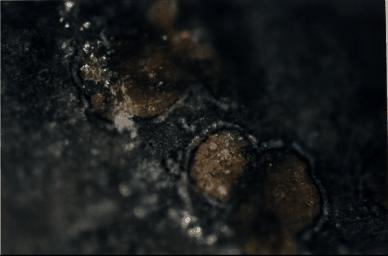
|
Mars Life? - Orange-colored Carbonate Mineral Globules
- Click the image above for a larger view
- Full-Res JPEG (651 x 430) (26.6 kB)
- Full-Res TIFF (651 x 430) (529.3 kB)
Caption:
This photograph shows orange-colored carbonate mineral globules found in a meteorite, called ALH84001, believed to have once been a part of Mars. These carbonate minerals in the meteorite are believed to have been formed on Mars more than 3.6 billion years ago. Their structure and chemistry suggest that they may have been formed with the assistance of primitive, bacteria-like living organisms. A two-year investigation by a NASA research team found organic molecules, mineral features characteristic of biological activity and possible microscopic fossils inside of carbonate minerals such as these in the meteorite.
Background Info:
A NASA research team of scientists at the Johnson Space Center and at Stanford University has found evidence that strongly suggests primitive life may have existed on Mars more than 3.6 billion years ago. The NASA-funded team found the first organic molecules thought to be of Martian origin; several mineral features characteristic of biological activity; and possible microscopic fossils of primitive, bacteria-like organisms inside of an ancient Martian rock that fell to Earth as a meteorite. This array of indirect evidence of past life will be reported in the Aug. 16 issue of the journal Science, presenting the investigation to the scientific community at large to reach a future consensus that will either confirm or deny the team's conclusion.
Cataloging Keywords:
| Name | Value | Additional Values |
|---|---|---|
| Target | Mars | |
| System | ||
| Target Type | Planet | |
| Mission | Antarctic Meteorite Location and Mapping Project (AMLAMP) | |
| Instrument Host | ||
| Host Type | ||
| Instrument | ||
| Detector | ||
| Extra Keywords | Color | |
| Acquisition Date | ||
| Release Date | 1996-08-08 | |
| Date in Caption | ||
| Image Credit | NASA/JSC/Stanford University | |
| Source | photojournal.jpl.nasa.gov/catalog/PIA00290 | |
| Identifier | PIA00290 | |
